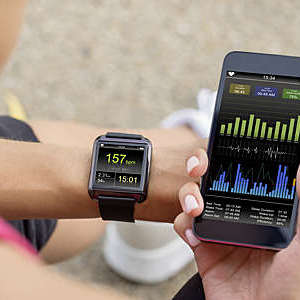After the long winter, getting outside and moving around is a great way to stay healthy and enjoy the warmer weather. But summer is also peak time for outdoor sports injuries. Here’s how ISO’s technical committee for sports and other leisure pursuits keeps you safe and active in the sun.
One step ahead with mobile apps


We all know prevention is better than cure, so with the expansion of mobile apps and the rapidly evolving functionalities that they offer, our chances of improved health are looking stronger. But what are the pitfalls, and how can manufacturers iron out the creases and make them even safer, more secure and packed with healthy goodness?
Calories consumed, calories burned, blood pressure or blood sugar, steps walked or metres climbed… there’s seemingly no end to what we can measure from the comfort of our wrists. As we are increasingly used to having everything we need at the swipe of a finger, the developers of apps are meeting this desire and helping to fuel the trend, with estimates showing that the number of health and fitness apps has risen from around 325 000 in 2017 to somewhere between 400 000 to 500 000 in 2019, according to specialist research consultancy R2G.

The evolution of this technology is moving as fast as our thirst for such information is growing. And so is the recognition of its usefulness. Germany, for example, is expected to pass a law sometime this year that will allow doctors to prescribe health apps, and other countries are expected to follow suit.
So, what exactly is health and wellness? The World Health Organization defines it as “a state of complete physical, mental and social well-being and not merely the absence of disease or infirmity”. Todd Cooper, an international expert in standards-based health informatics and medical device technology, and Chair of the US Technical Advisory Group (US/TAG), believes the surge in apps related to health and wellness has been driven by this desire for a more holistic approach to health.
Health and wellness are largely based on nutrition and lifestyle factors – things that are outside the traditional medical setting. “This fits perfectly into the world of apps,” says Cooper, “and there is a greater use of health apps as people become more aware of their health, more intrigued by technology, and look for alternatives to have more control over their destiny.”
Apps schnapps
There are a number of different kinds of app technology currently on the market. Some feature internal sensors that measure what is going on inside our bodies, others measure external sensory information such as temperature. Some sensors, like those used in the medical field, can sense changes to our health even before we do. Then, of course, there are all the algorithms and the calculations they can do in a way that we can’t – well, not easily, at least. This covers the whole parade of features including calorie counting, distances covered, body mass index, progress we make in terms of weights and reps, and so on.

There are a number of different kinds of app technology currently on the market.
Commonly used apps include Headspace for meditation, MyFitnessPal for counting calories and Endomondo Sports Tracker, which integrates the GPS on your phone with your physical activity to track movements and measure distance and calories. There are also sleep apps that measure sleep cycles and wake you up at the right moment, others that help you quit smoking by tracking your cravings and progress, and yet others that enable you to perform an ECG on an Apple Watch and share with your doctor.
Add the above to the profusion of motivational apps on the market that provide tailored recommendations based on the plethora of information we are able to provide and you could argue that, if used correctly, apps have the power to change the world. So what’s the catch?

Assessing the risks
As with any trend, when an industry grows, so too do the potential risks. It’s about real risk and perceived risk, notes Cooper. “Wanting to use an app to find the lowest-priced gasoline within five miles is one thing. If it isn’t accessible or gives me bogus guidance, oh well, better luck next time,” he says. “However, when health is involved, the risks become much more personal, ranging from a slight inconvenience to having to call the emergency services, to even death. If an app for medication dosage gets it wrong by putting the decimal point in the wrong place, for example, the effect can be disastrous.”
Gora Datta, an international expert on e-health and mobile ICT to ISO/TC 215, ISOʼs technical committee for health informatics, says risks also lie in the fact that health apps can have access to highly detailed, personally identifiable and clinical information about the user. “This clearly raises questions about privacy, security, permission control and confidentiality, as well as the integrity of the infrastructure,” he suggests.
“There is also a need to clarify how to ensure practicalities of data storage and management, availability and maintenance of the network, not to mention compatibility and interoperability.” Some standards and regulations already exist to help. For example, the US Food and Drug Administration (FDA) recognizes many of the benefits of health information technology but requires that risk assessments are carried out and risks appropriately managed. In its report titled FDASIA Health IT Report – Proposed Strategy and Recommendations for a Risk-Based Framework, the FDA states: “A nationwide health IT infrastructure can offer tremendous benefits to the American public, including the prevention of medical errors, improved efficiency and healthcare quality, reduced costs, and increased consumer engagement. However, if health IT is not designed, developed, implemented, maintained, or used properly, it can pose risks to patients.” So, while there is a strong public health case for the use of mobile health apps, the identification, development and adoption of standards and best practices are a key aspect of a health IT framework that promotes innovation and protects patient safety.

Standards to the foreground
So what does the standards landscape look like? Well, in recent years, many organizations have been looking into the thorny issue of health IT. The International Electrotechnical Commission (IEC), for instance, goes part of the way to guiding app developers. Published in 2010, its International Standard IEC 80001-1, Application of risk management for IT-networks incorporating medical devices – Part 1: Roles, responsibilities and activities, defines the functions a responsible organization must accomplish to identify, mitigate and manage the risks associated with putting medical devices and systems on the IT network.
However, there is currently no established and dedicated mobile health app certification process that can ensure apps are safe, reliable and secure. In 2015, ISO’s member for the UK, BSI, published PAS 277, Health and wellness apps. Quality criteria across the life cycle. Code of practice. Well received in the UK, and taking into account the fast-growing market of health and wellness apps and the concerns about their quality and reliability, this publicly available specification provides guidance on key issues to be aware of when developing medical apps. Given its positive reception, it was clear there was a need for guidance at the international level that would draw on harmonized national-level efforts and combined expertise from all over the world. To that end, ISO/TC 215 is working in collaboration with technical committee CEN/TC 251, Health informatics, of the European Committee for Standardization, to develop a dedicated technical specification for health and wellness apps for international use.
In addition, Health Level Seven International (HL7), a not-for-profit standards development organization accredited by ANSI, ISO’s member for the USA, made some inroads into this area when, in June 2018, it released for trial use its Consumer Mobile Health Application Functional Framework (cMHAFF), a standard that provides guidance to mobile health app developers.
trust your app
Currently in the making, future technical specification ISO/TS 82304-2, Health software – Part 2: Health and wellness apps – Quality and reliability, which is to be used alongside IEC 82304-1, Health software – Part 1: General requirements for product safety, intends to provide confidence in health software products such as apps. It is being developed by ISO/TC 215’s joint working group JWG 7 in collaboration with CEN/TC 251. In addition, the document focuses on “those aspects of health, wellness and healthcare, that are increasingly being used by individuals and being integrated into healthcare informatics,” explains Nicholas Oughtibridge, Co-Convenor of JWG 7.
ISO/TS 82304-2 will provide requirements for the development of health and wellness apps designed to meet the needs of healthcare professionals, patients, caregivers and the wider public. “It will contain a set of quality criteria and cover the app project’s life cycle through the development, testing, release and updating of an app, including native, hybrid and web-based apps, apps associated with wearable and other health equipment and apps that are linked to other apps,” he details.
The potential impacts are many. The technical specification will provide guidance to any company that develops apps and will be useful not just for technology companies but for national health technology regulators and government healthcare providers. Cooper adds that its use will also benefit consumers, consumer advocacy organizations and healthcare researchers, among others. What’s more, it is poised to contribute directly to the United Nations Sustainable Development Goals 3 (Good Health and Well-being) and 9 (Industry, Innovation and Infrastructure).
Born out of international consensus, ISO/TS 82304-2, which is due to be published sometime next year, is tipped to be a unique platform for innovation in the health sector, allowing for safer, more effective technologies to be developed. With the rise in ageing populations and the increasing number of chronic illnesses linked to lifestyle choices, effective mobile apps, developed and used correctly, cannot come soon enough. What’s more, they will put the responsibility of health back into the hands of the consumer, with safety and privacy at their core. Here’s raising a glass to their good health!

Wellness
Our well-being issue provides wellness tips, looks into the benefits of sport and e-bike standards, discusses medical spas and thalassotherapy and provides you with loads of insights in the booming medical tourism industry.
/en/2020/ISOfocus_141/ISOfocus_141.jpg/thumbnails/300)



